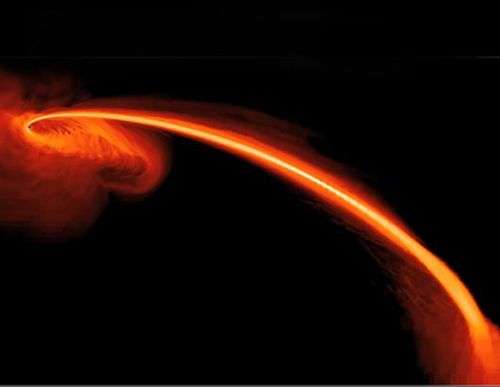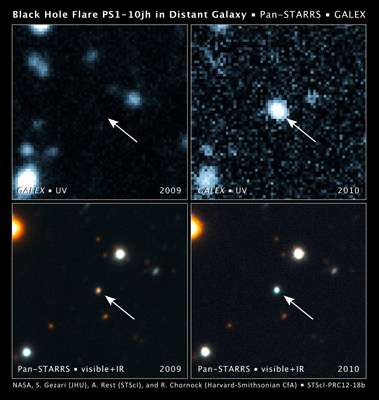It looks like you're using an Ad Blocker.
Please white-list or disable AboveTopSecret.com in your ad-blocking tool.
Thank you.
Some features of ATS will be disabled while you continue to use an ad-blocker.
8
share:

Astronomers have gathered the most direct evidence yet of a supermassiveblack hole shredding a star that wandered too close in a galaxy 2.7 billion light-years away. . NASA's Galaxy Evolution Explorer, a space-based observatory, and the Pan-STARRS1 telescope on the summit of Haleakala in Hawaii wereamong the first to help identify the stellar remains.
The computer-simulated image above shows gas from a star falling into a black hole. Astronomers, reporting in the journal Nature, say they observed a flare in ultraviolet and optical light, telling them there was a black hole tearing a star apart.
Supermassive black holes, weighing millions to billions times more than the sun, lurk in the centers of most galaxies. These hungry monsters lie quietly until an unsuspecting victim, such as a star, wanders close enough to get ripped apart by their powerful gravitational clutches.
Using several ground- and space-based telescopes, a team of astronomers led by SuviGezari of the Johns Hopkins University, Baltimore, Md., identified the victim as a star rich in helium gas.
Read the whole paper here
Here's the video:
This computer simulation shows a star being shredded by the gravity of a massive black hole. Some of the stellar debris falls into the black hole and some of it is ejected into space at high speeds.
The areas in white are regions of highest density, with progressively redder colors corresponding to lower-density regions. The blue dot pinpoints the black hole's location. The elapsed time corresponds to the amount of time it takes for a sun-like star to be ripped apart by a black hole a million times more massive than the sun. (Credit: NASA; S. Gezari, The Johns Hopkins University; and J. Guillochon, University of California, Santa Cruz)

These images, taken with NASA's Galaxy Evolution Explorer (GALEX) and the Pan-STARRS1 telescope in Hawaii, show a brightening inside a galaxy caused by a flare from its nucleus. The arrow in each image points to the galaxy. The flare is a signature of the galaxy's central black hole shredding a star that wandered too close to it.
The top left image, taken by GALEX in 2009, shows the galaxy's location before the flare. The galaxy is not visible in this ultraviolet-light exposure. In the top right image, taken by GALEX on June 23, 2010, the galaxy has become 350 times brighter in ultraviolet light.
The bottom left image, taken by Pan-STARRS1, shows the galaxy (the bright dot in the center) in 2009 before the flare's appearance. The bottom right image, taken by Pan-STARRS1 from June to August 2010, shows the flare from the galaxy nucleus. Note how the light from the flare is much bluer (hotter) than the host galaxy light.
Source: hubble site
edit on 3-5-2012 by elevenaugust because: (no
reason given)
Wow good find.
Black holes always intrigued me.
Good things its far away from us
/Kurdman
Black holes always intrigued me.
Good things its far away from us
/Kurdman
Originally posted by KurdishKing
Good things its far away from us
It also happened 2.7 billion years ago. I don't know how long black holes last for,
That reminds me of this:
I wonder what would happen if went you back in time 100 years and told everyone that invisible circular holes existed in the universe that could one day swallow us up. I also wonder what we will discover in the next 100 years about our galaxy.
I wonder what would happen if went you back in time 100 years and told everyone that invisible circular holes existed in the universe that could one day swallow us up. I also wonder what we will discover in the next 100 years about our galaxy.
edit on 3-5-2012 by questforevidence because:
reply to post by questforevidence
Reminds me of this one:
Soundgarden would have been my second guess.
Reminds me of this one:
Soundgarden would have been my second guess.
Thanks for the post. Black holes are a frightening part of the Universe. I've always wondered what it might look when a star came in contact with
one. The animation is great. It really gives you a sense of how fast that black hole can sling that star around, causing it to come apart. The
mechanics of our Universe are amazing and make me feel really small Star and flag OP!
TXML
TXML
Originally posted by SpearMint
Originally posted by KurdishKing
Good things its far away from us
It also happened 2.7 billion years ago. I don't know how long black holes last for,
What do you mean happened 2.7 billion years ago ?
reply to post by blackmetalmist
Simple in the OP text : in a galaxy 2.7 billion light-years away. so it's take 2.7 billion years for this light to travel here
Simple in the OP text : in a galaxy 2.7 billion light-years away. so it's take 2.7 billion years for this light to travel here
It looks like that poor star got completely shredded on the first pass and the bulk of it's remains got slung out in that spiral type pattern. Power
on that magnitude is kind of terrifying
this is either a very unusual supernova or an entirely different type of event, such as a star being ripped apart by a black hole,’
from this post
The evolution of the White Dwarf from a star such as ours has been detailed.
The black hole composition, solid neutrons packing and what physics hold, is from large Suns
or galactic centers and that does not seem to be the case here from the images of a few stars.
I would give you a star for this post but it might get sucked in as well
Do Black Holes swallow ATS stars
Do Black Holes swallow ATS stars
reply to post by elevenaugust
wow, beautiful, scary & powerful (under statement ). And to get the head around the fact it happened so long ago!!! Would hate to be closer
wow, beautiful, scary & powerful (under statement ). And to get the head around the fact it happened so long ago!!! Would hate to be closer
reply to post by elevenaugust
[more
Great thread OP, it's scary how powerful these things are just flicking a star around like an unwanted bogie.
I would like to ask a couple of question's if you don't mind: has anyone have a theory as to how much energy a black hole can absorb? . Is there a time when the singularity can absorb no more energy and just go pop?
I have read that both Prof Hawkins and Prof Brian Cox have stipulated that singularity in a black hole can evaporate, but they didn't say what would happen to all the energy that they have had absorbed over the millennial. Any ideas? Or am I totally barking up the wrong tree on this?
[more
Great thread OP, it's scary how powerful these things are just flicking a star around like an unwanted bogie.
I would like to ask a couple of question's if you don't mind: has anyone have a theory as to how much energy a black hole can absorb? . Is there a time when the singularity can absorb no more energy and just go pop?
I have read that both Prof Hawkins and Prof Brian Cox have stipulated that singularity in a black hole can evaporate, but they didn't say what would happen to all the energy that they have had absorbed over the millennial. Any ideas? Or am I totally barking up the wrong tree on this?
new topics
-
Putin, Russia and the Great Architects of the Universe
ATS Skunk Works: 37 minutes ago -
A Warning to America: 25 Ways the US is Being Destroyed
New World Order: 5 hours ago -
President BIDEN's FBI Raided Donald Trump's Florida Home for OBAMA-NORTH KOREA Documents.
Political Conspiracies: 10 hours ago
top topics
-
President BIDEN's FBI Raided Donald Trump's Florida Home for OBAMA-NORTH KOREA Documents.
Political Conspiracies: 10 hours ago, 28 flags -
A Warning to America: 25 Ways the US is Being Destroyed
New World Order: 5 hours ago, 10 flags -
Gaza Terrorists Attack US Humanitarian Pier During Construction
Middle East Issues: 17 hours ago, 8 flags -
Las Vegas UFO Spotting Teen Traumatized by Demon Creature in Backyard
Aliens and UFOs: 15 hours ago, 6 flags -
2024 Pigeon Forge Rod Run - On the Strip (Video made for you)
Automotive Discussion: 16 hours ago, 4 flags -
Is AI Better Than the Hollywood Elite?
Movies: 12 hours ago, 3 flags -
Maestro Benedetto
Literature: 12 hours ago, 1 flags -
Putin, Russia and the Great Architects of the Universe
ATS Skunk Works: 37 minutes ago, 1 flags
active topics
-
Putin, Russia and the Great Architects of the Universe
ATS Skunk Works • 7 • : RussianTroll -
"We're All Hamas" Heard at Columbia University Protests
Social Issues and Civil Unrest • 286 • : FlyersFan -
A Warning to America: 25 Ways the US is Being Destroyed
New World Order • 9 • : Lazy88 -
President BIDEN's FBI Raided Donald Trump's Florida Home for OBAMA-NORTH KOREA Documents.
Political Conspiracies • 21 • : CriticalStinker -
SETI chief says US has no evidence for alien technology. 'And we never have'
Aliens and UFOs • 75 • : Hecate666 -
Las Vegas UFO Spotting Teen Traumatized by Demon Creature in Backyard
Aliens and UFOs • 13 • : FlyersFan -
Mood Music Part VI
Music • 3105 • : BrucellaOrchitis -
The Acronym Game .. Pt.3
General Chit Chat • 7752 • : bally001 -
Is AI Better Than the Hollywood Elite?
Movies • 18 • : Hecate666 -
Hate makes for strange bedfellows
US Political Madness • 49 • : network dude
8
